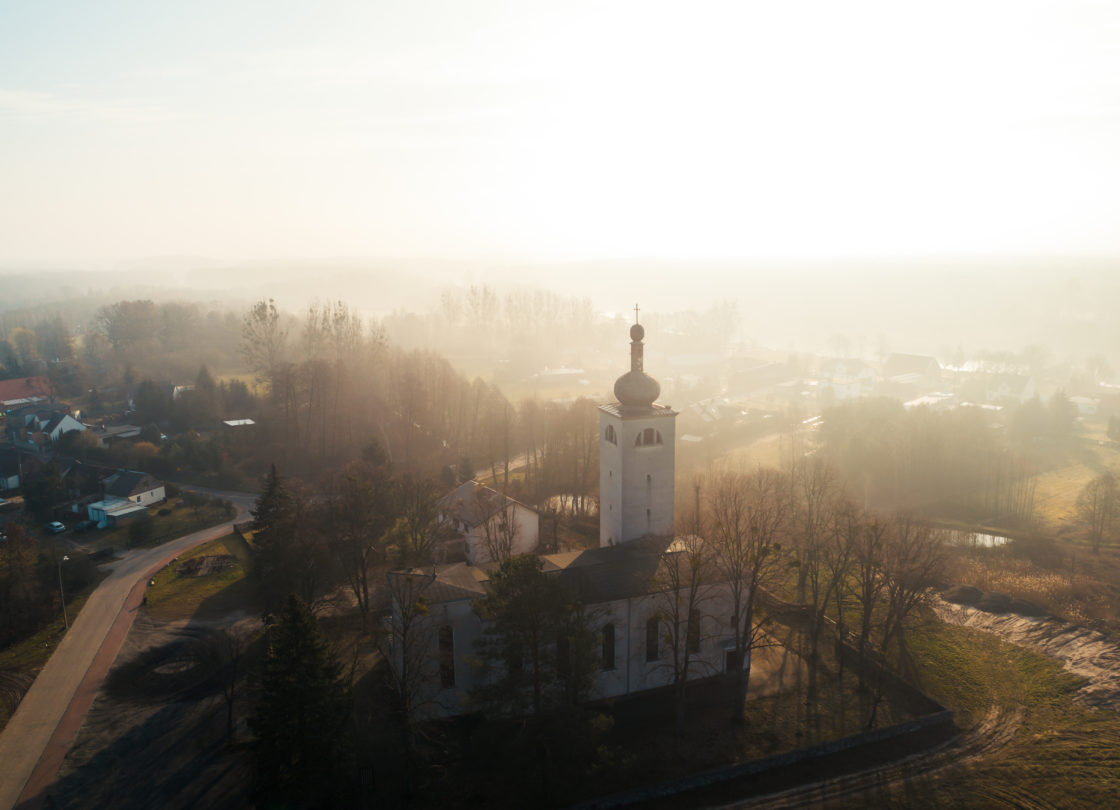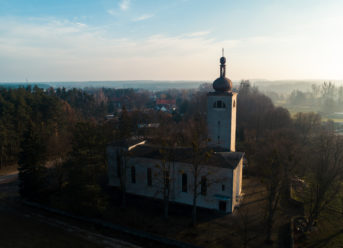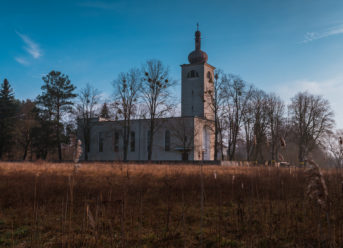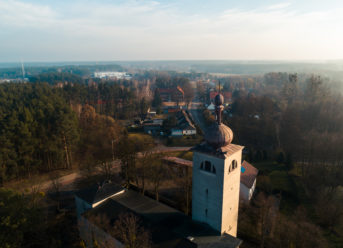Kościół Najświętszego Serca Jezusowego i św. Anny w Kiszewie
Die Pfarrgemeinde in Kiszewo
Church of the Sacred Heart of Jesus and St. Anna in Kiszewo
Teren, który zajmuje obecnie parafia Kiszewo, był zamieszkały już w czasach przedchrześcijańskich. Pod wsią odnaleziono bowiem pogańskie cmentarzysko. W XI i XII wieku zamieszkiwał na tym terenie potężny ród Nałęczów. Nie jest znana dokładna data powstania kiszewskiej parafii, lecz pierwszą o niej historyczną wzmiankę datuje się na rok 1407. Dostępne źródła donoszą, że kościół w Kiszewie był w rękach protestanckich, jednak pod koniec wieku XVI był już bardzo zniszczony, lub spalił się. Na początku wieku XVII za sprawą Stanisława Kiszewskiego, właściciela Kiszewa i jednocześnie opata lubińskiego parafia stała się prepozyturą klasztoru benedyktyńskiego w Lubiniu i pozostała nią aż do roku 1787. Brakuje w źródłach dowodów na wzniesienie nowego budynku, a istnienie drewnianego kościoła św. Anny potwierdzają dokumenty z wizytacji przeprowadzanych tam w latach benedyktyńskiej administracji.
Po opuszczeniu przez Benedyktów parafii przez szereg lat w Kiszewie nie było duszpasterstwa, a parafię postanowiono połączyć z leżącą nieopodal Stobnicą, plany te pokrzyżował 1 kwietnia 1823 roku pożar wsi, który strawił również kościół, plebanię, i budynki gospodarcze. Ponowne starania o zbudowanie kościoła w Kiszewie i wznowienie parafii czyniono od roku 1858. Myśl ta nie ustępowała w okresie po I wojnie światowej. W roku 1922 wybudowano na miejscu dawnego kościoła kaplicę pod wezwaniem św. Izydora. Rozbudowano ją w r. 1924. Nowy kościół w zupełnie nowym miejscu powstał w roku 1934. Otrzymał tytuł Najświętszego Serca Jezusowego i św. Anny, 26 października 1936 dekretem erekcyjnym wznowiono parafię Kiszewo, przydzielając do niej 9 okolicznych wiosek.
Położony w centrum wsi kościół jest również unikatowym w skali regionu siedliskiem nietoperzy. Nieużytkowane poddasze, znajdujące się nad nawą główną i prezbiterium kościoła stało się dla nich doskonałą kryjówką. W sąsiedztwie kiszewskiego kościoła stwierdzono obecność co najmniej 8 gatunków nietoperzy. Wszystkie objęte są ścisłą ochroną.
Die ersten Siedlungsspuren stammen aus den vorchristlichen Zeiten. Im Gebiet des ehemaligen Dorfes wurden Reste eines Heidenfriedhofs gefunden. Im 11. und im 12. Jh. gehörte das Dorf der mächtigen Adelsfamilie Nałęcz. Wann genau die Gemeinde in Kiszewo gegründet wurde, ist unbekannt. Sie wurde aber im Jahre 1407 erstmals urkundlich erwähnt. Laut den Quellenangaben sollte die erste Kirche im evangelischen Ritus errichtet worden. Sie wurde aber zerstört, wahrscheinlich verbrannt. Zu Beginn des 17. Jhs. wurde die Pfarrei auf Auftrag von dem Dorfbesitzer, dem Abt der Benediktinerordner in Lubin Stanisław Kiszewski errichtet. Die hölzerne St. Anna-Kirche wurde in den Urkunden als Stift Benediktinerordner erwähnt. Nachdem die Benediktiner im Jahre 1787 das Gebiet verließen, entschied man, die Gemeinde Kiszewo mit der nahe liegenden Gemeinde Stobnica zu verbinden. Zur Verbindung kam es aber nicht, denn inzwischen, genau am 1. April 1823 brannte die Kirche in Kiszewo mit dem Pfarrhaus und seinen Wirtschaftsgebäuden komplett nieder. Die Bemühungen zum Wiederaufbau wurden im Jahre 1853 und dann nach dem Ersten Weltkrieg unternommen. 1922 entstand an der Stelle der verbrannten Kirche eine St. Isidor-Kapelle, die im Jahre 1924 ausgebaut wurde. Für den Bau der heutigen Kirche hat man einen ganz anderen Grundstück gewählt. Am 26. Oktober 1936 wurde die Gemeinde mit 9 anliegenden Dörfern gegründet. Die im höchsten Punkt des Dorfes liegende Kirche wurde dem Allerheiligsten Herzen Jesu und der heiligen Anna eingeweiht.
In den letzten Jahren ist die Kirche auch durch Fledermäuse bekannt. Sie nutzen den nicht bewohnten Dachboden, der sich über dem Hauptschiff und dem Presbyterium befindet. Da haben die Fledermäuse viele Hang- und Versteckmöglichkeiten. In der Umgebung wurden 8 Fledermausarten festgestellt, alle unter Naturschutz.
The area which is the parish of Kiszewo was already inhabited in pre-Christian times. A pagan cemetery was found under the village. In the 11th and 12th century the powerful Nałęcz family lived in this area. The exact date of the Kiszewo parish's establishment is unknown, but the first historical mention of it dates back to 1407. Available sources report that the church in Kiszewo was in Protestant hands, but by the end of the 16th century it was in poor condition or burnt down. At the beginning of the 17th century, thanks to Stanisław Kiszewski, the owner of Kiszewo and at the same time the abbot of Lubin, the parish became a delegation of the Benedictine monastery in Lubin and remained so until 1787. There is no evidence of a new building being erected, and the existence of the wooden St. Anne's Church is confirmed by documents from visits carried out there during the Benedictine administration years. After the Benedictes left the parish for a number of years, there was no pastoral ministry in Kiszew, and the parish was decided to merge with nearby Stobnica, which was crossed by a fire in the village on April 1, 1823, which also consumed the church, the rectory, and outbuildings. In 1922, a chapel of St. Isidor was built on the site of the former church. It was extended in 1924 and in a different place a new church was built in 1934. He received the title of the Sacred Heart of Jesus St. Anne, and on 26 October 1936 the parish of Kiszewo was resumed by decree of erection, assigning 9 surrounding villages to it.
Located in the centre of the village, the church is also a unique bat habitat in the region. The unused attic, located above the main nave and the church's presbytery has become a perfect hiding place for them. At least 8 species of bats have been found in the vicinity of the Kiszewo church. All of them are under strict protection.






